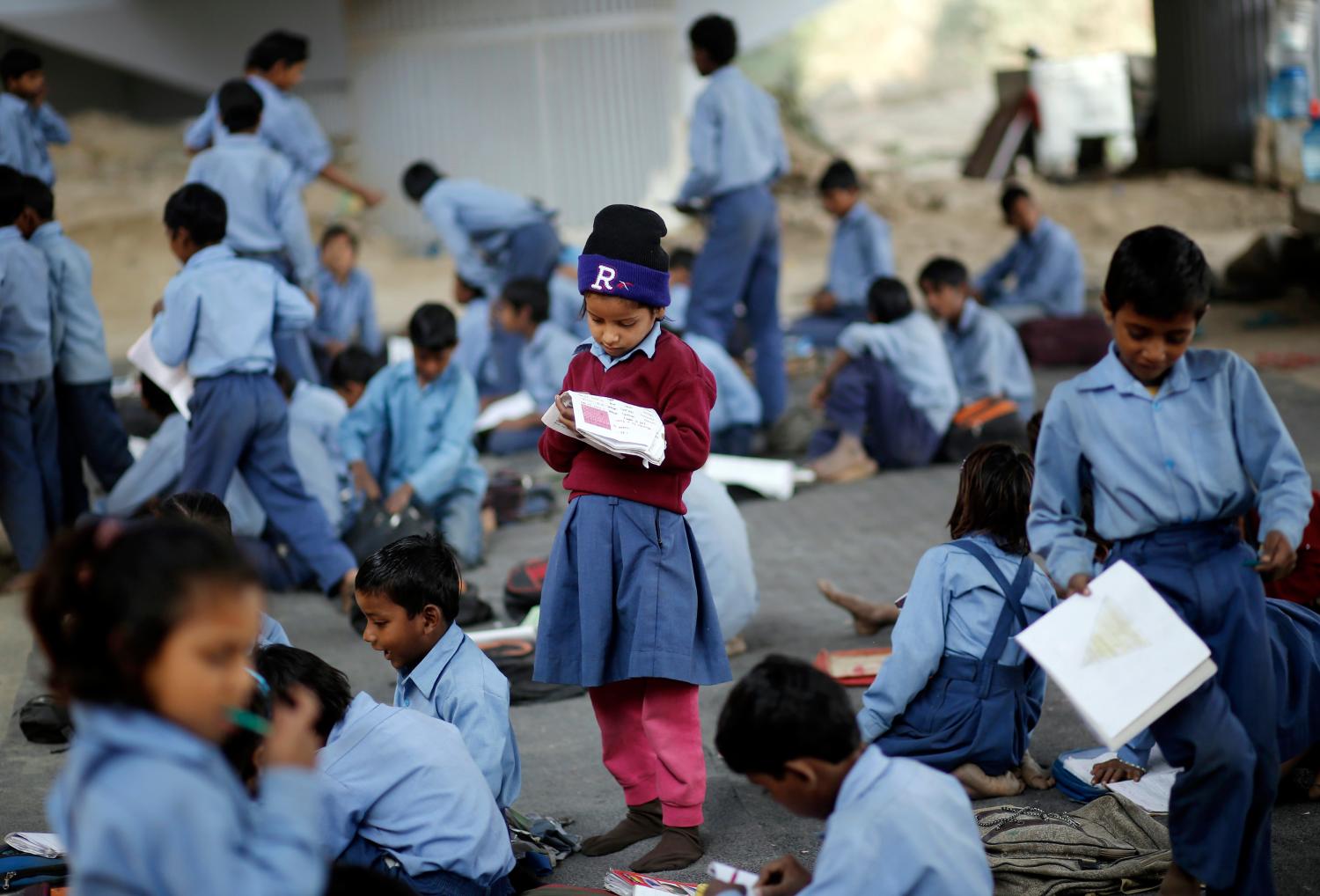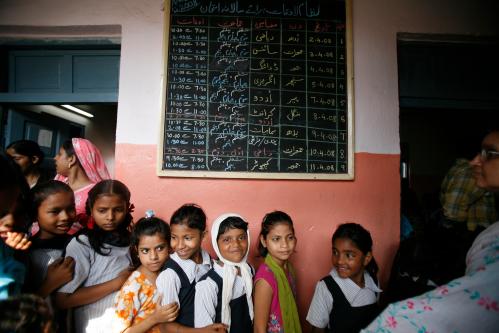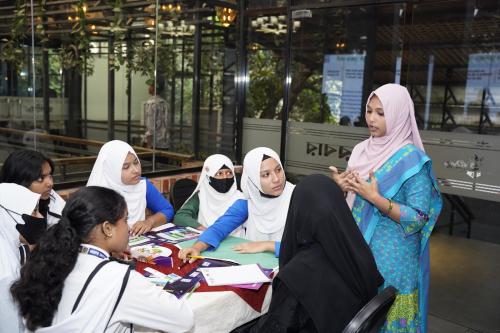Content from the Brookings Institution India Center is now archived. After seven years of an impactful partnership, as of September 11, 2020, Brookings India is now the Centre for Social and Economic Progress, an independent public policy institution based in India.
In recent decades India has made significant progress on access to schooling and enrollment rates in primary education but dropout rates and low levels of learning remain challenges for the state and central government. As the U.S. has a longer history of public education than India there are opportunities for India to learn from the successes and failures in the American education system and to collaborate in tackling shared challenges, such as the best use of technology in primary education.
Primary school enrollment in India has been a success story, largely due to various programs and drives to increase enrolment even in remote areas. With enrollment reaching at least 96 percent since 2009, and girls making up 56 percent of new students between 2007 and 2013, it is clear that many problems of access to schooling have been addressed. Improvements to infrastructure have been a priority to achieve this and India now has 1.4 million schools and 7.7 million teachers so that 98 percent of habitations have a primary school (class I-V) within one kilometer and 92 percent have an upper primary school (class VI-VIII) within a three-kilometer walking distance.
Despite these improvements, keeping children in school through graduation is still an issue and dropout rates continue to be high. Nationally 29 percent of children drop out before completing five years of primary school, and 43 percent before finishing upper primary school. High school completion is only 42 percent. This lands India among the top five nations for out-of-school children of primary school age, with 1.4 million 6 to 11 year olds not attending school. In many ways schools are not equipped to handle the full population – there is a teacher shortage of 689,000 teachers in primary schools, only 53 percent of schools have functional girls’ toilets and 74 percent have access to drinking water.
Additionally, the quality of learning is a major issue and reports show that children are not achieving class-appropriate learning levels. According to Pratham’s Annual Status of Education 2013 report, close to 78 percent of children in Standard III and about 50 percent of children in Standard V cannot yet read Standard II texts. Arithmetic is also a cause for concern as only 26 percent students in Standard V can do a division problem. Without immediate and urgent help, these children cannot effectively progress in the education system, and so improving the quality of learning in schools is the next big challenge for both the state and central governments.
Improving learning will require attention to many things, including increasing teacher accountability. According to school visits teacher attendance is just 85 percent in primary and middle schools and raising the amount of time teachers spend on-task and increasing their responsibility for student learning also needs improvement. Part of this process requires better assessments at each grade level and more efficient monitoring and support systems. Overall, the public school system also needs a better general management system.
India also faces many challenges that could be tackled through the education system. For one gender issues have come to the fore because of the spate of recent cases of violence against girls. Changing gender mindsets seems to be imperative and gender studies education is one way of doing so. Also India, along with most countries, is concerned with the future of the labor market and employability; Prime Minister Mr. Narendra Modi wants to emphasize skill development in order to make school education more practically relevant.
Areas of Collaboration
Many of India’s concerns about education are shared by the U.S., such as ensuring quality, improving teacher capabilities, effective use of technology, and improving management systems. The US and India can achieve better learning outcomes if they pool their experience and resources – both intellectual and economic.
Leveraging technology: Both the U.S. and India are looking for solutions to provide high-quality learning opportunities to marginalized students. Technology has a lot of potential to improve education but how it can be implemented most effectively and in the case of India, most cost-effectively, still remains a question. There are several initiatives in India, by NGOs, like the Azim Premji Foundation & Digital Studyhall, and corporations like ILFS, Educom, Intel, Medialabs, to mention just a few, in content creation, teacher training and classroom learning. So far philanthropists and incubators are the ones who have helped to identify and scale best practices. A more officially driven effort is required to evaluate digital content and even more importantly to develop cost effective methods of making these available to teachers and students in areas where resources are scarce. Prime Minister Modi has shown a keen interest in this area, mentioning the need for ‘digital classrooms’ several times in his speeches in India and abroad. Given the issues of scale in terms of numbers and geography, which India needs to tackle in order to reach all her children and make sure they are learning effectively, technology definitely has an important role to play. The U.S. and India could collaborate and work to understand together how technology might be leveraged to improve student learning, teacher training, monitoring and support, management of schools and the quality of learning, especially in remote districts. The U.S. already has much experience in providing technology to schools and India could learn from its successes and failures. Furthermore, collaboration with the U.S. could help promote research in this area and build the evidence base in India.
Teacher education: The lack of learning in India’s schools call for changes to teacher education. A collaboration between American universities’ schools of education with Indian teacher training institutes could help build capacity and upgrade teacher education both in terms of curriculum and pedagogy, which is much needed in Indian teacher education institutions like the District Institutes of Education and Training. Such collaborations could be facilitated through technology, collaborative research projects, teacher exchanges, and subsidized online courses for teachers in India by universities in the United States.
Building good assessment systems: Good assessments are useful at the classroom level for teachers to gauge their students’ understanding and also to inform policy. The need for regular and useful assessments in India is something that Indian departments of education are focusing on at the central and state level. The U.S. could share lessons learned on how to make assessments as effective as possible in terms of assessment design, implementation and management of data.
Gender studies education: The state of women in India has recently drawn a lot of attention and promoting gender equality through education has an important role to play. Boys and girls should be taught to think about gender equality from an early age and the curriculum should include gender studies with appropriate teacher training. The U.S. could share its experiences of promoting gender equality through schools and help advance both action and research.
Skills Development: As making education more practically relevant to the labor market is a priority for Prime Minister Modi, there is much India can learn from experiences in the United States. A shared agenda of helping identify and implement improved ways to develop skills and competencies even at the school level could be an important area for collaboration.
Resources: Currently spending on education is low in India, and stands at 3.4 percent of the GDP. The U.S. might be able to help make it more of a priority, and nudge the government to increase spending on education.
The Brookings Institution is committed to quality, independence, and impact.
We are supported by a diverse array of funders. In line with our values and policies, each Brookings publication represents the sole views of its author(s).










